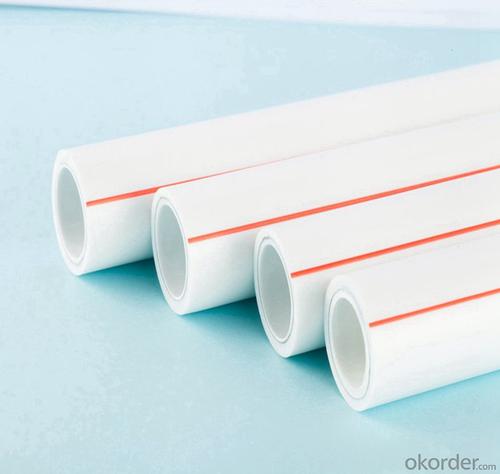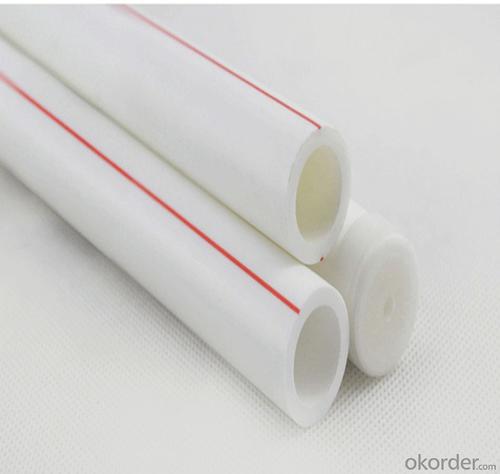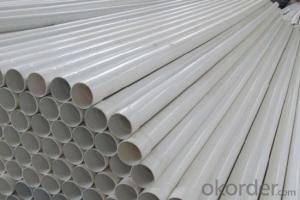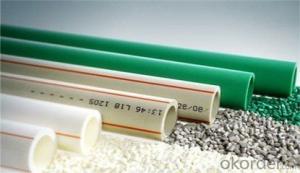Plastic Tubes PPR Pipe Watering Irrigation for Industrial Fields - Made in China
- Loading Port:
- Dalian
- Payment Terms:
- TT OR LC
- Min Order Qty:
- 1000 pc
- Supply Capability:
- 100000 pc/month
OKorder Service Pledge
OKorder Financial Service
You Might Also Like
Product Overview
PP-R (polypropylene random) tube called type three polypropylene pipe and is also called the PP-R pipe or PPR pipe, with energy saving, environmental protection, high strength, corrosion resistance, with smooth inner wall has the advantages of scale, construction and easy maintenance, long service life, widely used in building water supply and drainage, urban drainage city gas and power cable sheath, and industrial fluid transportation, agricultural irrigation construction, municipal, industrial and agricultural fields. The PP-R pipe is made of random copolymerized polypropylene and is extruded into tubes to be molded into tubes.
Application
1. Cold and hot water pipe system.
2. Potable drinking water system.
3. Air conditioning pipeline system.
4. Chemical industry pipelines system.
5. Indoor heating system, high temperature radiator heating system
Product Description
Pressure | Size(mm) | Pressure | Size(mm) |
PN1.25MPA | 20*2.0 |
PN1.6MPA | 20*2.3 |
25*2.3 | 25*2.8 | ||
32*2.9 | 32*3.6 | ||
40*3.7 | 40*4.5 | ||
50*4.6 | 50*5.6 | ||
63*5.8 | 63*7.1 | ||
75*6.8 | 75*8.4 | ||
90*8.2 | 90*10.1 | ||
110*10.0 | 110*12.3 |
Product Show



FAQ
Q1: How Can I Get A Sample?
A1: You can get samples by communicate with our export sales.
Q2: How Long Is Delivery?
A2: Delivery time will be30-45days according to order quantity.
Q3: What Is The MOQ?
A3: MOQ depends on different items.
Q4: What Is Our Normal Payments Terms?
A4: Our normal payment terms now is: T/T, L/C or western union, pay
- Q: My friend gave me a bunch of mortars and i have never set off mortars before and i was wondering what you could use for a tube. Also how long does it need to be? first answer gets voted best by me
- Fiberglass Mortar Tubes
- Q: It's kind of like a slushy. What's it called?
- ice pops?
- Q: where can i get a print out of all the clored tubes and what test is used for each tube for a phlebotomists ?
- Blood collection tubes must be drawn in a specific order to avoid cross-contamination of additives between tubes. The recommended order of draw for plastic vacutainer tubes is: First - blood culture bottle or tube (yellow or yellow-black top) Second - coagulation tube (light blue top). If just a routine coagulation assay is the only test ordered, then a single light blue top tube may be drawn. If there is a concern regarding contamination by tissue fluids or thromboplastins, then one may draw a non-additive tube first, and then the light blue top tube. Third - non-additive tube (red top) Last draw - additive tubes in this order: SST (red-gray or gold top). Contains a gel separator and clot activator. Sodium heparin (dark green top) PST (light green top). Contains lithium heparin anticoagulant and a gel separator. EDTA (lavender top) ACDA or ACDB (pale yellow top). Contains acid citrate dextrose. Oxalate/fluoride (light gray top)
- Q: Can plastic tubes be used for oil and gas industries?
- Yes, plastic tubes can be used in the oil and gas industries. Plastic tubes, specifically those made from high-density polyethylene (HDPE) or polyvinyl chloride (PVC), are commonly used for various applications in the oil and gas sector. They are suitable for transporting fluids, chemicals, and gases due to their resistance to corrosion, chemicals, and abrasion. Plastic tubes can offer cost-effectiveness, durability, and ease of installation, making them a viable choice for certain oil and gas industry needs.
- Q: What are the different closure options for flip-top tubes?
- Some of the different closure options for flip-top tubes include snap-on caps, screw-on caps, and squeeze-to-open caps.
- Q: He was talking about dope before he offered me a smoke, but when he offered me a smoke from his clear plastic tube, I asked what it was, and if I remember right he said Marijuana.He had to use his glasses to push whatever was in it to the end.I had never been high before, my heart was racing, and I was VERY talkative and loud.
- Marijuana isn't smoked in a glass tube, it may be used in a hookah or a rolled cigarette, but not glass tube or pipe. That is usually crack cocaine or meth. I won't offer advice, but that friend put your life in danger, first not telling you, and second, giving you something so addictive.
- Q: What supplies do you gather to remove an NG tube and what is the care for the pt. afterwared?
- If you don't know...Get a nurse or a doctor to help you. You should not do it if you haven't been instructed to do so. A nurse usually does it.
- Q: I've heard about crop feeding but the website im learning it from suggest that i don't crop feed if i'm not experienced, instead i should just mix the formula, and put it directly into the pigeons mouth.But how do i do this? i know that sounds stupid, but this baby is 2 weeks old and i want to make sure that i do this correctly.thanks
- What I do is use a Dixie cup and punch a hole into it so birds beak will fit in it and place beak in hole and let them eat up the food. Pigeons put their beaks in mothers mouth and throat to eat so this is more natural for them and less chance of aspiration. Or you can try the syringe and place it down into the throat over to the side. Can you contact a wildlife rehabber to take these babies? Call the DEC or local vet who will be able to refer you. It is free. good luck.
- Q: Are plastic tubes resistant to bending or flexing?
- Yes, plastic tubes are generally resistant to bending or flexing due to their rigid nature.
- Q: What is the maximum length of plastic tubes available?
- The maximum length of plastic tubes available can vary depending on the manufacturer, but they are commonly available in lengths ranging from a few inches to several feet.
Send your message to us
Plastic Tubes PPR Pipe Watering Irrigation for Industrial Fields - Made in China
- Loading Port:
- Dalian
- Payment Terms:
- TT OR LC
- Min Order Qty:
- 1000 pc
- Supply Capability:
- 100000 pc/month
OKorder Service Pledge
OKorder Financial Service
Similar products
Hot products
Hot Searches
Related keywords



























